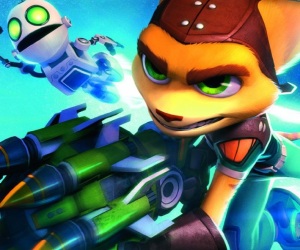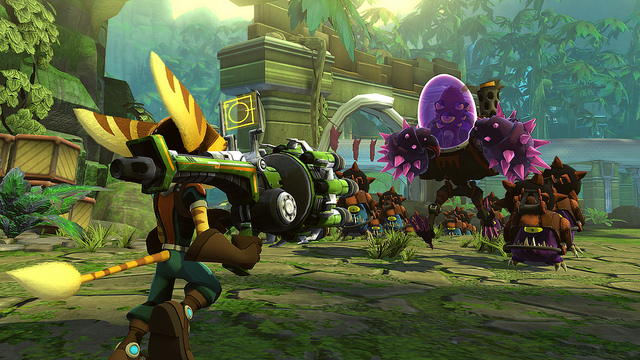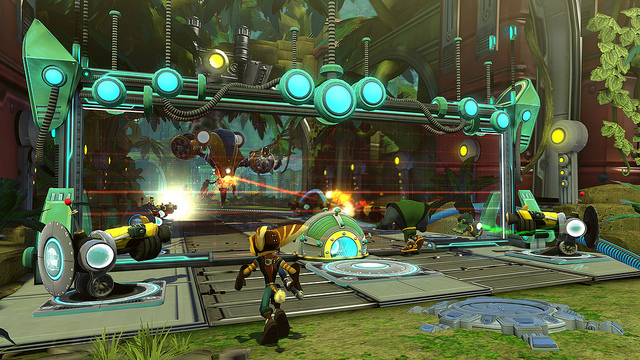 Game: Ratchet & Clank: Q-Force
Game: Ratchet & Clank: Q-Force
Developer: Insomniac Games
Publisher: Sony Computer Entertainment
Available on: PlayStation 3 and PlayStation Vita
Reviewed on: PlayStation 3
Insomniac Games have never been known to rest on their laurels and, as a result, their Ratchet & Clank series is one that has seen its fair share of transformations over the years as the developers experiment time and again with the established format.
The newest game, subtitled Q-Force (or Full Frontal Assault across the Atlantic), is a relatively small-scale entry that might have been a straight downloadable title had it not been for the graphical clout behind it. As it is, Q-Force is hitting retail at a reduced price, with a Vita version due in January (and free if you by this version, thanks to Sony’s excellent crossplay initiative).
Q-Force’s story is an uncomplicated affair that sees courageous lombax Ratchet and wily robot Clank teaming up with long-time ally Captain Qwark as the elite Q-Force of the title, to defend the galaxy from invading Grungarians. The enemy is led by Zurgo, a masked menace who – in a twist that’s almost a nod to The Incredibles’ Syndrome – is revealed to be a disgruntled former super-fan of Qwark, now disillusioned and betrayed by the big green dolt’s recent string of embarrassments. It’s a paper thin plot, as you might expect, but it sets up the central conceit nicely.

Unlike the 4-player All 4 One released last year, Q-Force is neither a linear adventure nor an action platformer; at least not in the real sense. Instead it takes the familiar platforming elements, third person gunplay, fast-paced exploration and simple-but-effective melee combat and throws them all into a great big grinder along with tower defence and rocket-powered hover-boots. Each level requires you to locate and activate a planet’s defensive shields by deactivating a number of Key Nodes to unlock the Planetary Defence Centre, before heading back to protect your own base until said defences come online.
The levels are a mix of vibrant forests and rocky crags and, while there isn’t a lot of variety, each one is the kind of colourful riot you would expect from a Ratchet & Clank game – and there’s plenty to do in all of them thanks to a host of collectible artwork and cheats that can be activated on your second playthrough. Enemies and crates can both be smashed to harvest bolts (a series staple), with which to buy defences such as turrets, mines and shields to protect your base from attack, and there’s a certain simple joy to be had in cruising around the level at high speed (R2 activates your hoverboots for an uninterrupted speed boost), collecting bolts and mashing up alien monsters.
Combat mixes gunplay and melee attacks as is standard, but thankfully Insomniac have taken the weapon wheel off of the right stick, which was a major annoyance in All 4 One, and mapped it to the Triangle button instead. Such a seemingly minor change is made even more important here by Q-Force’s massive arsenal, which includes flame throwers, cryo-cannons, rocket launchers, decoy dopplegangers and, of course, Mr. Zurkon, the most psychotic robot companion since KOTOR’s HK-47.
The downside to all the breakneck hover-booting and frequent combat is that the poor area map and incredibly busy vistas make the levels easy to get turned around in, especially when either you or your base is under attack for the umpteenth time. Most irritating is the latter, because you’ll need to drop what you’re doing like a hot potato and charge back to defend your HQ; and it almost always seems to happen right when you find a Key Node or have just fought your way through the legions of enemies guarding the Defence Centre. Co-op makes things easier, of course, as you can divvy up the duties, but when playing solo it can get overwhelming very fast, as can coordinating the end-of-level defence on your own. I say “coordinating”, but I really mean juggling between killing hordes of enemies bent on destroying your precious generators and replacing your weak-ass turrets and shields with the stingy supply of bolts.
Multiplayer is a little more structured, as each match is divided into three segments that run on a continuous loop until someone wins. In either 1-on-1 or 2-on-2 games, your job here is of a similar vein to the campaign, but with a few added bells. During Recon phase, your objective is to capture Nodes via the same minigame by which you acquire weapons in solo mode. These Nodes are heavily guarded, but the more you have each round, the more bolts you’ll earn to build defences and call down alien infantry during the Squad phase; infantry that will march on your opponent’s base during the Assault phase. It’s not as complicated as it sounds, and, in fact, the multiplayer mode is the brightest highlight despite its lack of real scope (one mode over four maps is all you get). The only real issue is that there’s such a huge variety of weapons it will take time to work out what’s best for each situation, and less-experienced teams will be torn apart by veterans in moments without much time to take stock and learn the ropes.
What stops Q-Force from hitting the heights of greatness – aside from its short, 4-5 hour length – is its lack of variety. New ideas are a good thing, always, and often – especially with Ratchet & Clank – so are new directions, but there aren’t really enough of either in Q-Force. The defence mechanics, while fun, lack depth, and although the script is as sharp as ever the characters seem stuck in a kind of timewarp wherein they never evolve beyond aesthetic tweaks. The hoverboots make getting around easier, but the levels are confusing and the map is next to useless. For every thumbs-up, there’s a thumbs-down waiting to happen.

VERDICT: Despite an undeniable current of fun, Ratchet & Clank: Q-Force struggles to match the high quality co-op of All 4 One and instead presents its own version of tower defence that raises a smile, but is ultimately a fairly shallow and repetitive affair. For all Insomniac Game’s dice-rolling and experimentation, Q-Force suggests that the series is past its best and may never recapture the bygone glories of, say, Up Your Arsenal or Going Commando, which is a great shame when you consider that the problem isn’t Insomniac’s passion for the franchise, but their lack of real direction.
Ultimately, Q-Force is a slice of fun that, particularly at the low price, is a more than worthy investment for established fans – and its new direction makes it an interesting, if late, entry point to the series. Just don’t go into it expecting anything truly revolutionary, while at the same time keeping an open mind about the changes, and you may find yourself pleasantly surprised.






